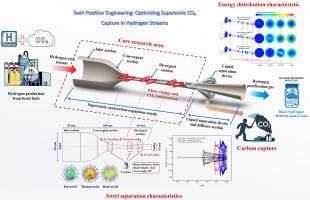涡流位置对富氢流中超声速CO2凝聚和能量分布的影响:喉道-涡流优化策略
IF 7.7
2区 工程技术
Q1 CHEMISTRY, APPLIED
引用次数: 0
摘要
超音速冷凝分离技术为氢净化和碳捕获带来了希望。研究了H2-CO2混合物的冷凝和能量分布机理,提出了一种喷嘴喉旋优化策略。利用欧拉-欧拉多相流模型,我们建立了一个整合真实气体方程、旋流效应和CO2非平衡冷凝动力学的数值框架。设计了一种新型的喉道-旋流结构,并与前置旋流和后旋流方案进行了比较,同时从轴向和径向两个维度分析了富氢流的能量分布。结果表明,喉道-旋流方案具有较高的成核率(J = 2.6 × 1023 m−3·s−1)和湍动能(k = 1312.5 m2·s−2),促进了叶尖处细液滴的形成,解决了后旋流方案的膨胀限制。凝聚液滴密度显著影响能量分布,湍流动能在管壁处达到峰值,并沿气流方向增大。喉-旋流方案有效地平衡了冷凝和分离效率。该研究揭示了涡流位置如何调节能量分布影响冷凝和分离,为超音速分离器的设计和清洁氢技术的进步提供了见解。本文章由计算机程序翻译,如有差异,请以英文原文为准。

Impact of swirl position on supersonic CO2 condensation and energy distribution in hydrogen-rich streams: A throat-swirl optimization strategy
Supersonic condensation separation technology holds promise for hydrogen purification and carbon capture. This study investigates the condensation and energy distribution mechanisms of H2-CO2 mixtures and proposes a nozzle throat-swirl optimization strategy. Using an Euler-Euler multiphase flow model, we developed a numerical framework integrating the real gas equation, swirl effects, and CO2 non-equilibrium condensation dynamics. A novel throat-swirl configuration was designed and compared with pre-swirl and rear-swirl schemes, while analyzing the energy distribution of the hydrogen-rich stream in axial and radial dimensions. Results demonstrate that the throat-swirl scheme achieves superior nucleation rates (J = 2.6 × 1023 m−3·s−1) and turbulent kinetic energy (k = 1312.5 m2·s−2), promoting fine droplet formation at the blade tip and addressing expansion limitations of the rear-swirl approach. Condensed droplet density significantly influences energy distribution, with turbulent kinetic energy peaking at the tube wall and increasing along the airflow direction. The throat-swirl scheme effectively balances condensation and separation efficiency. This work reveals how swirl position regulates energy distribution to impact condensation and separation, offering insights for supersonic separator design and clean hydrogen technology advancement.
求助全文
通过发布文献求助,成功后即可免费获取论文全文。
去求助
来源期刊

Fuel Processing Technology
工程技术-工程:化工
CiteScore
13.20
自引率
9.30%
发文量
398
审稿时长
26 days
期刊介绍:
Fuel Processing Technology (FPT) deals with the scientific and technological aspects of converting fossil and renewable resources to clean fuels, value-added chemicals, fuel-related advanced carbon materials and by-products. In addition to the traditional non-nuclear fossil fuels, biomass and wastes, papers on the integration of renewables such as solar and wind energy and energy storage into the fuel processing processes, as well as papers on the production and conversion of non-carbon-containing fuels such as hydrogen and ammonia, are also welcome. While chemical conversion is emphasized, papers on advanced physical conversion processes are also considered for publication in FPT. Papers on the fundamental aspects of fuel structure and properties will also be considered.
 求助内容:
求助内容: 应助结果提醒方式:
应助结果提醒方式:


